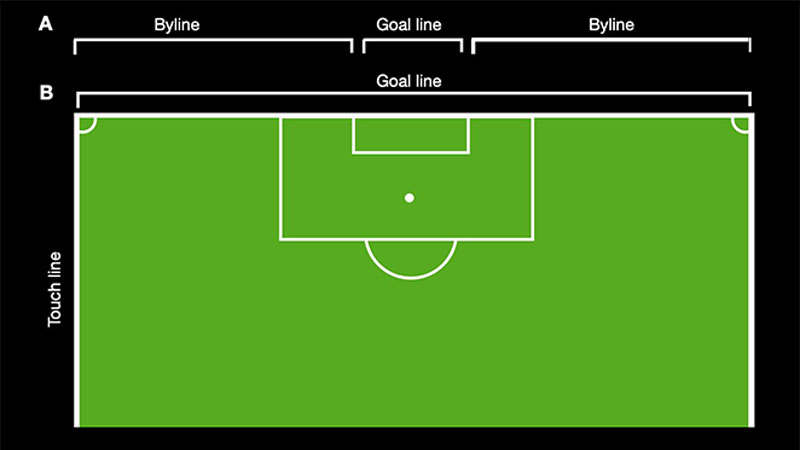When you’re watching a soccer match, you’ll often hear commentators mention the “byline.” But what exactly is it? In soccer, the byline is the portion of the goal line that extends outside the goalposts.
It plays a crucial role in the game, influencing corner kicks, goal kicks, and the overall strategy of both teams.
Understanding the byline is essential for grasping the nuances of soccer. For instance, when the ball crosses the byline after being last touched by a defender, the attacking team gets a corner kick.
Conversely, if the ball crosses the byline off an attacking player, it results in a goal kick for the defending team. This simple boundary can significantly impact the flow and outcome of a match.
The Strategic Role of the Byline in Soccer
The byline, an essential part of the soccer field, lies at the end of the playing area outside the goalposts. Its role is pivotal in many match situations.
Definition and Location
The byline, also called the endline in American soccer terminology, is the boundary line that runs parallel to the goal line. It marks the end of the soccer field on both ends. The byline extends beyond the goalposts, forming the rear boundary of the field.
Importance in Gameplay
In gameplay, the byline influences several critical match decisions:
- Corner Kicks: If the ball crosses the byline last touched by a defender, the attacking team receives a corner kick, offering a significant goal-scoring opportunity.
- Goal Kicks: Conversely, if the ball crosses the byline last touched by an attacker, the defending team is awarded a goal kick, allowing them to clear the ball from their defensive area.
- Strategic Play: Teams often use the byline to execute crosses into the penalty area, creating scoring opportunities. Understanding its use can help players make decisive moves.
Grasping the byline’s concept is essential for players and spectators alike, as it directly affects the game’s flow and outcome.
Rules Related to the Byline
The byline plays a significant role in several soccer regulations that impact gameplay. Understanding these rules enhances your comprehension of the game.
Offside and Byline Interaction
An offside position occurs when a player is nearer to the opponent’s goal line than both the second-last opponent and the ball. The byline essentially acts as a reference point in determining offside decisions.
If a player stands beyond the byline, they are not considered offside.
Goal Kick and Corner Kick Regulations
The byline determines whether a goal kick or a corner kick is awarded. A goal kick is given when the ball crosses the byline after being last touched by an attacking player. Conversely, a corner kick is awarded when the ball crosses the byline after being touched by a defending player.
The exact spot of the goal kick or corner kick is where the ball crosses the byline, making precise positioning crucial for these set plays.
Byline Strategy in Matches
In soccer, the byline plays a key role in both offensive and defensive strategies. Teams use the byline to create scoring opportunities and defend against attacks effectively.
Attacking Tactics
Attackers can exploit the byline to stretch the defense, creating more space in the penalty box and generating high-quality scoring chances through crosses. Wing players can deliver low cutback crosses, which are difficult for defenders to manage.
Set pieces like corner kicks also offer substantial scoring opportunities, confusing defenses and leading to goals via headers or volleys. Quick footwork and feints by forwards near the byline further enhance scoring possibilities by cutting the ball back into the penalty area.
Defensive Considerations
Defending the byline is crucial for stopping dangerous crosses and cutbacks, requiring defenders to block attackers from reaching this area and delivering crosses. Good positioning is key; defenders should push attackers toward the touchline to limit their options.
Fullbacks and wingers must work together defensively to cover the byline, and defenders should clear the ball toward the touchline rather than conceding corner kicks. Goalkeepers also play a role by positioning themselves to intercept crosses and support defenders.
Mastering byline strategies enhances team performance in both creating and preventing scoring opportunities.
Comparison of Byline Usage
The byline’s function in soccer contrasts with its roles in other football codes and international matches. Understanding these differences can enhance your knowledge of the game.
Byline in Different Football Codes
In association football, also known as soccer, the byline’s primary roles include determining corner kicks and goal kicks. The purpose remains the same in other football variants like rugby and American football but with different contextual applications.
- Rugby: The byline, called the dead-ball line, marks the end of the field of play. Players or the ball crossing this line stop the play.
- American Football: Here, the lines are referred to as end lines. They delineate the boundaries of the end zone, an area where scoring plays such as touchdowns occur.
- Australian Rules Football: The byline functions similarly to rugby, marking the end of the playing field but with unique rules for actions like scoring and out-of-bounds plays.
International Variations in Byline Rules
The byline’s role can vary slightly in international soccer, influenced by governing bodies such as FIFA, UEFA, and local federations.
- FIFA: The standard rules state that the byline determines corner and goal kicks without deviation in international fixtures.
- UEFA Competitions: Typically follow the same guidelines as FIFA but may include clarifications for specific tournaments, ensuring consistent application across all matches.
- Local Federations: Different national leagues and competitions might adopt slight variations. These sometimes involve the width of the byline markings or the execution of set plays originating from near the byline.
Understanding these differences in byline usage across various football codes and international rules can help you better grasp the game’s strategic elements, enhancing both your viewing and playing experiences.
Frequently Asked Questions
What happens if a player is standing beyond the byline?
If a player is standing beyond the byline, they are considered off the field of play. This affects offside decisions and whether a goal kick or corner kick is awarded depending on how the ball exits the field.
How does the byline compare in different football codes?
In rugby, American football, and Australian Rules Football, the byline signifies the end of the field of play. Each sport uses the byline to denote boundaries but with varying rules and strategic implications specific to each code.
Are there variations in byline rules in international soccer?
Yes, international soccer organizations like FIFA, UEFA, and local federations have variations in byline rules. Familiarizing oneself with these differences is essential for understanding the strategic elements of the game.
What is the role of the byline in determining goal and corner kicks?
When the ball crosses the byline, it results in a goal kick if last touched by an attacker, or a corner kick if last touched by a defender. This rule helps determine how play is restarted.
How does standing beyond the byline affect offside decisions?
Players standing beyond the byline are generally not considered in play for offside purposes. Offside rules only apply to players on the field and those involved in active play.
Conclusion
Understanding the byline in soccer can significantly enhance your grasp of the game’s strategic elements. Whether it’s about determining corner kicks or goal kicks or influencing offside decisions the byline plays a crucial role.
Knowing how different football codes use the byline and recognizing the variations in international soccer rules can give you a deeper appreciation of the sport.
By mastering these nuances you’ll be better equipped to enjoy and analyze soccer at a higher level. Whether you are a seasoned fan or a newcomer, understanding these rules and their applications will enrich your viewing experience.
Next time you watch a match, pay close attention to how players and referees interact with the byline—it’s more than just a boundary; it’s a key part of the game’s intricate strategy.








Brice Petersen